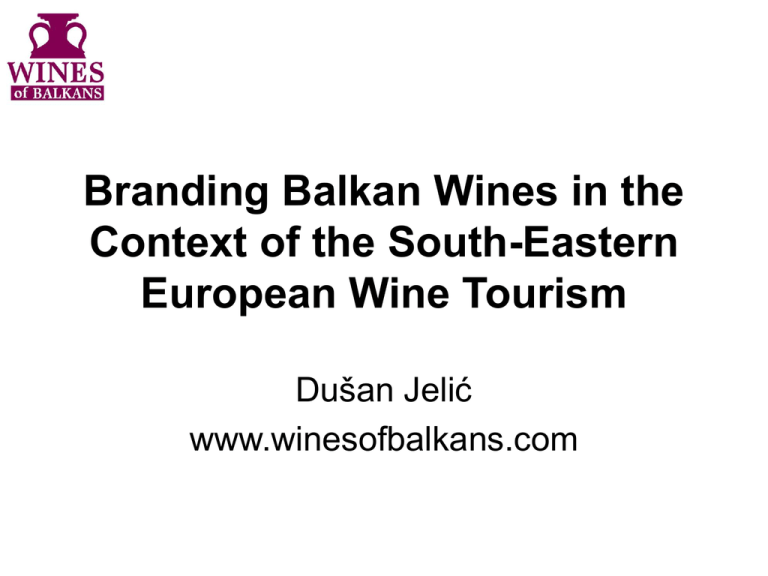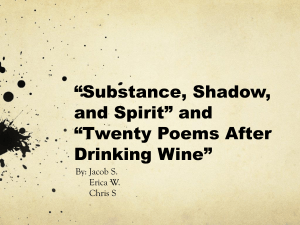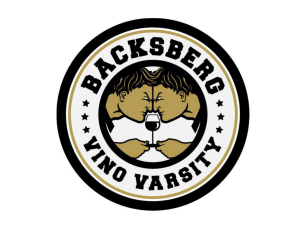Branding Balkan Wines in the Context of the South
advertisement

Branding Balkan Wines in the Context of the South-Eastern European Wine Tourism Dušan Jelić www.winesofbalkans.com [1] Introduction. An Abstract. • Branding Balkan Wines in the Context of the SouthEastern European Wine Tourism • Creating a marketing tool relying on synergy among wine producers and promoters of the regional wines • Linking the Balkan wine industry with wine tourism [2] The Balkans. A Brief Historical Introduction. • Balkan Peninsula extends from the Black Sea to the Mediterranean • Balkan history: the rise and fall of empires, monarchies, dictatorships, communistsocialist systems & democracies • Priority: the region is overwhelmingly oriented towards joining the European Union [3] Wines of Balkans. Indigenous vs. International. South-Eastern Europe as a Gastronomic Heaven. • 1.8 million tons wine per year Balkan is 5th in the world (2,000+ wineries in the region’s 12 countries) • BIWC 2012 - creation of a powerful marketing tool which will rely on synergy among wine producers & promoters from all South-Eastern European countries • The BIWC 2013 will host representatives of the global wine connoisseur elite in order to draw the attention of the global wine community to the unique range of flavours that Balkan has to offer. [4] Principles of Wine Tourism • • • • • Tourism planning: economic, environmental, spatial, management, social, cultural, technological & political. Guiding Principles: sustainable, long-term planning and ‘public interest’, wine and food heritage, niche market, contribution to the general economic, environmental, social and cultural improvement of the nation/region as a whole The Wine tourism master plan should respond to the need to be competitive in the region Special features or attractions are the foundation for niche market tourism as so-called ‘unique selling points’. If basic principles are neglected - a lot of negative consequences [5] Interesting Points to Explore Further • Cellar door sale (interesting for the winemakers) vs. a total experience (desired by a tourist) • What if wine tourism infrastructure is nonexistent or it is poorly developed • National & regional tourist bodies (often) do not identify the wine tourism as the top marketing priority - the task is to change that! [6] The Big Question: What Should Be Done Now? • Wine Tourism bodies have to do the following: • Accurately segment national wine tourism destinations • Strategically position less well-know wine regions also as holiday destinations • Promotion of carefully selected wine tourism offerings which include winery + cellar visits with other top attractions in the respective regions • Vigorously encourage the packaging of wine estate visits with a diversity of tourist experiences [7] • • • • • • Implementation of the Wine Tourism Strategy Leadership (top quality management, i.e. Istria to Dalmatia) at each level of decision-making Master plan should be the outcome of an appropriate planning process The wine tourism strategy is responsive to Entrepreneurial initiative & Partnerships involving private enterprise - corporate or individual, traditional communities & the government The various sectors of decisionmaking (corporate, individual, traditional & governmental) operate in a negotiated framework. [8] • • • • • Characteristics of integrated wine tourism planning A decision-making structure designed to link wine tourism with other sectors of economic and infrastructure development An approach which is strategic and goal-oriented rather than being re-active and preventative A structure which can accommodate inputs and influences from the wine tourism industry, other sectors of government, and the affected community A process which is purposive and deliberate, but which is also flexible to adjust to changing circumstances A process which is guided by principles of good management and best practices [9] Wine Communications & Communicators #SocialMedia #WineOnline (via Arto Koskelo) • To be a wine expert is to take a stand & to be an opinion leader is to have opinions • To be a wine lover is to share your passion. The more you share it, the more you generate it. • Communicate your preferences clearly & follow your instinct! [10] Brief Case Studies • #1 Istrian Peninsula, Croatia (descriptions from Per Karlsson of BKWine.com) • #2 Development of Wine Tourism at Hvar Island, Croatia (with help of Paul Bradbury & Ivana Krstulović-Carić) • #3 Wine Tourism Academy based in Belgrade, Serbia (with help of Miloš Kalapiš)






